20884 ACE Language (Yr 3) Paragraphs
Create successful ePaper yourself
Turn your PDF publications into a flip-book with our unique Google optimized e-Paper software.
Format of the book.<br />
Paragraph search<br />
Understand that paragraphs are a key organisational feature of written texts (<strong>ACE</strong>LA1479)<br />
© Australian Curriculum: Assessment and Reporting Authority 2012<br />
R.I.C. Publications® www.ricpublications.com.au Australian Curriculum English<br />
Choose a page of a storybook or a library book organised in paragraphs to<br />
complete this page.<br />
1. What is the title of the book?<br />
2. Is it real or imaginative text?<br />
3. What is the number of the page are you looking at?<br />
4. Are there any subheadings on the page? Yes No<br />
5. Is there an illustration on the page? Yes No<br />
6. How many paragraphs are on the page?<br />
7. Does each paragraph start with a capital letter? Yes No<br />
8. Is there a space between each paragraph? Yes No<br />
9. How many sentences are in the first paragraph?<br />
10. Is the second paragraph shorter or longer than the first one?<br />
11. How many sentences are in the second paragraph?<br />
12. Which paragraph is the shortest? Paragraph<br />
13. Is there any speech in speech marks on the page? Yes No<br />
14. Does the last paragraph finish on this page or the next page?<br />
15. Do all the paragraphs end with a full stop? Yes No<br />
33<br />
Blackline masters<br />
and resource sheets<br />
are provided to support<br />
teaching and learning<br />
activities for each content<br />
description. These include<br />
worksheets for class use,<br />
games, charts or other<br />
materials which the teacher<br />
might find useful to use or<br />
display in the classroom.<br />
For each blackline master<br />
the content description to<br />
which it relates is given.<br />
Text structure<br />
and organisation<br />
Understand how different types of texts vary in use of language<br />
choices, depending on their purpose and context (for example, tense<br />
and types of sentences) (<strong>ACE</strong>LA1478)<br />
© Australian Curriculum: Assessment and Reporting Authority 2012<br />
Assessment<br />
checklist<br />
Each section has a checklist<br />
which teachers may find useful as<br />
a place to keep a record of their<br />
observations of the activities to<br />
develop the content descriptions.<br />
Student Name<br />
Understands that<br />
texts differ according<br />
to purpose and<br />
context<br />
Identifies the<br />
language and<br />
structural features of<br />
a narrative<br />
Identifies the<br />
language and<br />
structural features of<br />
a recount<br />
Identifies the<br />
language and<br />
structural features of<br />
a procedure<br />
Identifies the<br />
language and<br />
structural features of<br />
a report<br />
Identifies the<br />
language and<br />
structural features of<br />
a review<br />
Identifies the<br />
language and<br />
structural features of<br />
an explanation<br />
Identifies the<br />
language and<br />
structural features of<br />
an exposition<br />
Text structure<br />
and organisation<br />
Understand how different types of texts vary in use of language Interrelated<br />
choices, depending on their purpose and context (for example, tense<br />
and types of sentences) (<strong>ACE</strong>LA1478)<br />
English<br />
© Australian Curriculum: Assessment and Reporting Authority 2012<br />
links<br />
Below is a list of links within the <strong>Language</strong> strand, Literature strand and Literacy strand of English that are covered within the activities provided with the<br />
content description above:<br />
E1. Identifies and analyses the text structures and language features of different text types.<br />
Examine how evaluative language can be varied to be more or less forceful (<strong>ACE</strong>LA1477)<br />
Understand that paragraphs are a key organisational feature of written texts (<strong>ACE</strong>LA1479)<br />
Understand that verbs represent different processes (doing, thinking, saying, and relating) and that these processes are anchored in time through tense<br />
(<strong>ACE</strong>LA1482)<br />
Learn extended and technical vocabulary and ways of expressing opinion including modal verbs and adverbs (<strong>ACE</strong>LA1485)<br />
Recognise high frequency sight words (<strong>ACE</strong>LA1486)<br />
Discuss texts in which characters, events and settings are portrayed in different ways, and speculate on the author’s reasons (<strong>ACE</strong>LT1594)<br />
Discuss how language is used to describe the settings in texts, and explore how the settings shape the events and infl uence the mood of the narrative<br />
(<strong>ACE</strong>LT1599)<br />
Listen to and contribute to conversations and discussions to share information and ideas and negotiate in collaborative situations (<strong>ACE</strong>LY1676)<br />
Read an increasing range of different types of texts by combining contextual, semantic, grammatical and phonic knowledge, using text processing<br />
strategies, for example monitoring, predicting, confi rming, rereading, reading on and self-correcting (<strong>ACE</strong>LY1679)<br />
Use comprehension strategies to build literal and inferred meaning and begin to evaluate texts by drawing on a growing knowledge of context, text<br />
structures and language features (<strong>ACE</strong>LY1680)<br />
Plan, draft and publish imaginative, informative and persuasive texts demonstrating increasing control over text structures and language features and<br />
selecting print, and multimodal elements appropriate to the audience and purpose<br />
Reread and edit texts for meaning, appropriate structure, grammatical choices and punctuation (<strong>ACE</strong>LY1683)<br />
Write using joined letters that are clearly formed and consistent in size (<strong>ACE</strong>LY1684)<br />
Modes, capabilities and priorities covered by the<br />
activities in this content description<br />
<strong>Language</strong> modes General capabilities<br />
Listening Literacy<br />
<br />
Speaking Numeracy<br />
Reading<br />
Information and communication<br />
<br />
technology (ICT) capability<br />
<br />
Viewing<br />
Critical and creative thinking <br />
Writing<br />
Personal and social capability<br />
Ethical behaviour<br />
Intercultural understanding<br />
Cross-curriculum priorities<br />
Aboriginal and Torres Strait Islander histories and cultures <br />
Asia and Australia’s engagement in Asia<br />
<br />
Sustainability<br />
R.I.C. Publications® www.ricpublications.com.au Australian Curriculum English<br />
27<br />
Interrelated English links<br />
lists other links covered within<br />
the <strong>Language</strong> strand, Literature<br />
strand and Literacy strand of<br />
English that are incorporated in<br />
the activities provided with the<br />
content description. While the<br />
book’s approach focuses on the<br />
Text structure and organisation<br />
sub-strand, the links show the<br />
integration across the three<br />
strands.<br />
A table showing the <strong>Language</strong><br />
modes, General capabilities<br />
and Cross-curriculum priorities<br />
covered by the activities in each<br />
content description is provided.<br />
Answers for student worksheets<br />
are provided at the back of the<br />
book.<br />
Australian Curriculum English www.ricpublications.com.au R.I.C. Publications ®<br />
Text structure<br />
and organisation<br />
26<br />
Understand how different types of texts vary in use of language<br />
choices, depending on their purpose and context (for example,<br />
tense and types of sentences) (<strong>ACE</strong>LA1478)<br />
Answers<br />
© Australian Curriculum: Assessment and Reporting Authority 2012<br />
How the moon got into the sky ............. pages 12–13 Remote control ......................................... pages 20–21<br />
1. How the moon got into the sky<br />
1. Remote control<br />
2. Who? Aboriginal people of Cape York<br />
2. (a) (i) award-winning director (ii) popular child actor<br />
When? long ago<br />
3. (a) three (b) Paragraph 3<br />
Where? northern Queensland, Australia<br />
(c) (i) the adventure ends<br />
3. (a) There was light during the day but totally dark at night.<br />
(ii) a new adventure begins<br />
(b) 1. Some people suggested building a campfi re to make light.<br />
(iv) the adventure goes back to where it ended<br />
2. One person suggested making a boomerang that would shine. (d) Answers may include: receives, watches, realises, is, looks, sounds,<br />
3. The tribe made an enormous shining boomerang.<br />
has<br />
4. Although many people tried, no-one could throw the<br />
4. (a) certainly, thrill, action-packed<br />
boomerang high enough into the sky.<br />
(b) Because he gave it four stars out of fi ve.<br />
5. An old man asked if he could try to throw the boomerang. How do thermometers work? ................. pages 22–23<br />
4. The old man was able to throw the boomerang high enough into the 1. How do thermometers work?<br />
sky to make it stay there and shine down.<br />
2. temperature, heat, thermometers<br />
5. moon, look, night, boomerang<br />
3. (a) 4<br />
Flight to Fiji ............................................... pages 14–15 (b) (i) mercury<br />
1. Flight to Fiji<br />
(ii) rises, lowers/falls<br />
2. Who? Mum, Dad, I (writer), (writer’s) sister<br />
(iii) degrees<br />
When? during the school holidays<br />
(iv) thermistor<br />
Where? fl ying in a jet plane to Fiji<br />
(v) inks<br />
Why? for a week’s holiday<br />
(c) Teacher check<br />
3. (a) took a taxi ride to airport/Dad commented about the time the ride 4. Possible answers: taking a person’s temperature to see if it is above<br />
took<br />
normal,measuring the temperature of the weather, checking an oven’s<br />
(b) checked in baggage/boarded the plane<br />
temperature.<br />
(c) Teacher check<br />
Save our water! ....................................... pages 24–25<br />
4. The writer was glad it was time to land because they could soon collect 1. Save our water!<br />
their luggage and begin their holiday.<br />
2. (a) The writer wants people to save/preserve water by reducing the<br />
Musical rainstick ....................................... pages 16–17<br />
amount we use.<br />
1. Musical rainsticks<br />
(b) Worldwide water shortages will be a serious problem in the future.<br />
2. It is about following instructions to make a musical instrument that has 3. (a) fi ve<br />
a rain-like sound.<br />
(b) Teacher check<br />
3. (a) paintbrush (b) scissors (c) 2 paper towel tubes<br />
(c) Teacher check<br />
(d) 2 elastic bands<br />
(d) Only a small amount of our water is usable as most is salty or<br />
4. (a) 8<br />
undrinkable.<br />
(b) Students should have four of the following words: Decorate, Tape, 4. (a) precious<br />
Use, Push, Put, Place, Repeat, Tip<br />
(b) ... we must deal with it now!<br />
(c) (command) verbs<br />
(d) (i) 6 (ii) 4<br />
(e) (i) the, the (ii) the, some, them<br />
5. The answer should indicate that the instructions were followed so the<br />
rainstick sounded like rain when shaken.<br />
The Earth’s slowest mammal .................. pages 18–19<br />
1. The Earth’s slowest mammal<br />
2. The sloth, from the old English word meaning ‘slow’.<br />
3. (a) 5<br />
(b) (i) tropical, America (ii) upside down<br />
(iii) herbivores<br />
(iv) fur, colour, algae<br />
(c) helps, blend, hide<br />
4. (a) It won’t travel very far.<br />
(b) A snail and a sloth.<br />
Australian Curriculum English www.ricpublications.com.au R.I.C. Publications ®<br />
80<br />
R.I.C. Publications ® www.ricpublications.com.au Australian Curriculum English – <strong>Language</strong>: Text structure and organisation (Year 3)<br />
v


















